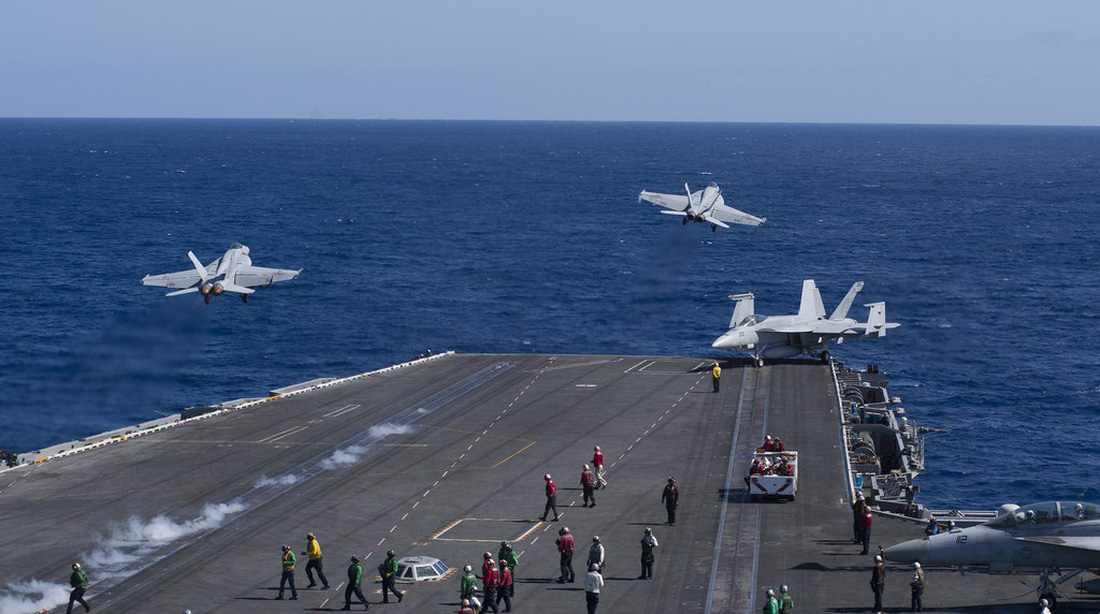Editor’s note: Vietnamese journalist Yen Ba recalled his visit to the U.S. Navy aircraft carrier USS Carl Vinson in October 2017, in this piece sent to Tuoi Tre (Youth) newspaper.
In the joint statement issued during U.S. President Donald Trump’s visit to Vietnam in November 2017, leaders from both countries showed their support for a visit by a U.S. Navy aircraft carrier to Vietnam somewhere in 2018.
The port call will be led by the USS Carl Vinson, the flagship of the Carrier Strike Group One under the U.S. Navy Third Fleet.
I had a chance to visit this aircraft carrier the other day in October 2017.
 |
| The USS Carl Vinson, the U.S. Navy's third Nimitz-class supercarrier, underwent refueling and an overhaul between 2005 and 2009. Photo: U.S. Navy |
'Situation Room’
On that morning, shortly after finishing breakfast, we were picked up from our hotel by a U.S. Navy car and taken to the Third Fleet headquarters in San Diego, California.
We were then brought to a room akin to the White House Situation Room, where operation orders are made.
A U.S. Navy sergeant named Nicholas Jenning then briefed us on some regulations and informed us that we would be flying to the USS Carl Vinson by a fixed-wing airplane, rather than by a helicopter as usual. As this kind of aircraft takes off and lands just as a fighter jet does, we had to wear a lifejacket equipped with a whistle and flare before boarding.
We were also wearing a helmet that looks just like that of an astronaut. It was not an easy experience taking a 35-to-40-minute flight above the sea with such a heavy and stuffy helmet.
Following the instruction briefing, we boarded a C-20 Grey Hound aircraft from its tail. There were only two round windows at both sides of the aircraft and we were seated facing its rear compartment.
Only minutes later did we find ourselves flying above the sea.
 |
| The USS Carl Vinson cost US$3.8 billion, carrying some 72 aircraft including FA18 Super Hornets and Hornets, EA 18G Growlers, Nighthawk helicopters and surveillance aircraft. Photo: U.S. Navy |
Landing
Forty minutes into takeoff, the C-20 made a curve and through the small side windows, we could start seeing the USS Carl Vinson there, standing marvelously above the Pacific waves.
Two U.S. soldiers in the front seats turned to us and waved their hands, shouting, “Here we are,” 30 seconds after which we made our landing on the aircraft carrier’s flight deck.
As with all aircraft carriers, where the short flight deck allows little runway space for landing planes, all landing is made with a tailhook, an extended hook attached to the plane's tail. During landing, a pilot must snag the tailhook on one of four arresting wires that are stretched across the deck and are attached on both ends to hydraulic cylinders below deck.
If the tailhook snags an arresting wire, it pulls the wire out, and the hydraulic cylinder system absorbs the energy to bring the plane to a stop.
The pilot always has to keep speeding the aircraft after it touches down on the flight deck, so it can take off again when the arresting wire fails to stop the plane.
In our case, the aircraft came to a halt only seconds after landing.
 |
| An F/A-18C Hornet launches from the aircraft carrier USS Carl Vinson (CVN 70) flight deck on April 8, 2017. Photo: U.S. Navy |
Airshow
We then entered a meeting to make a short courtesy call, taking off our lifejacket and putting on helmets with ear defenders, without which we could never be able to stand the deafening noise from the engines of a number of planes taking off and landing on the flight deck.
As we made it to the USS Carl Vinson deck, the ocean winds plus force from the planes were lashing through so fiercely that we found it hard to stand still, and all the cameras just waited to be thrown away from our hands.
For the next two hours from that point, we were treated to a display of several landing and takeoff stunts of the USS Carl Vinson planes.
We first watched a Bell Boeing V-22 Osprey as it landed and pulled to a stop by an arresting wire on the flight deck, before being wowed by the ‘one-touch land’ of the fighter aircraft F/A-18 Super Hornets.
The twine-engine was just there above the high sky when it descended at high speed, touching the flight deck once before immediately heading up again.
During our time aboard the USS Carl Vinson deck, different airplanes landed and took off from there on a frequent interval of three to five minutes.
One U.S. Navy officer told us that this is the normal training frequency on the aircraft carrier.
Goodbye
After two hours watching the landing-takeoff operations and being briefed on the relevant equipment and technology, we went to the dining room for crew members to have lunch.
Even when we were traveling on the sea, the aircraft carrier made no shaking and it is really like a ‘floating city,’ with a complicated pathway structure.
On our way to the dining room, we walked past the hangar deck, a huge space the size of a football (soccer) field that houses 75 airplanes.
The dining room serves buffet in different shifts as there are as many as 3,000 people on board.
After lunch, we toured the control tower, where all activities of the planes are overseen.
And it was time when our visit had to end.
Our flight to leave the USS Carl Vinson was yet another once-in-a-lifetime experience, when we were there inside the plane that went from 0 to 200kph in only two seconds during takeoff.
 |
| USS Carl Vinson crew members load missiles onto the aircraft carrier. Photo: U.S. Navy |
|
USS Carl Vinson (CVN-70) is the United States Navy's third Nimitz-class supercarrier and named for Carl Vinson, a Congressman from Georgia, in recognition of his contributions to the U.S. Navy. It is equipped with two Westinghouse A4W nuclear reactors, capable of traveling at 56kph. There are four takeoff lanes at the ship head, and one landing lane at its rear. The USS Carl Vinson carries some 3,000 crewmembers, nearly a third of which are female personnel, and 75 planes, including 65 F-35 or F-18 Hornet fighter jets. |
Like us on Facebook or follow us on Twitter to get the latest news about Vietnam!



















































